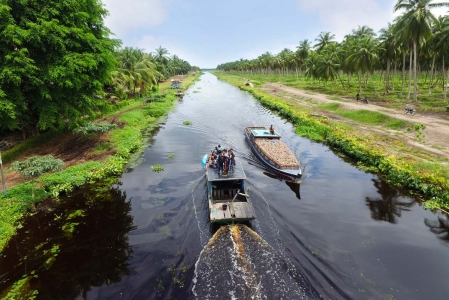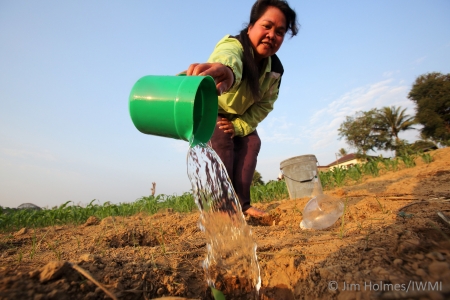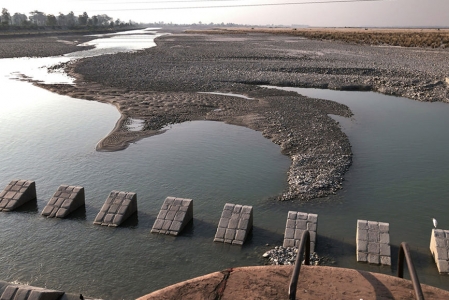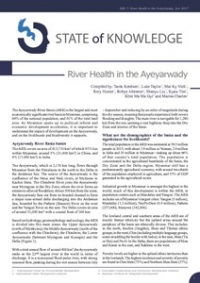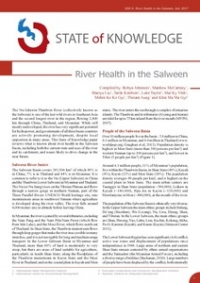This piece was originally published on the Chicago Council on Global Affairs blog. Read the original post.
In the long, hot summer of 1858, the city of London came to a standstill. Government could barely function. People stayed at home. This was not due to a major calamity but the overpowering stench that emanated from the River Thames. For too long, all of London’s waste – human, animal and industrial – had been dumped untreated in the river. Thanks to public pressure (and undoubtedly the mighty stink in the Houses of Parliament), the government finally acted. In just 18 days, legislation was passed to rehabilitate the whole river. Wild salmon, last seen in 1833, finally returned to the river in 2006.
Rivers throughout the world have long borne the brunt of human activities. The recipients of farmland runoff, plastic, and other trash, they are also damaged by deforestation, mining, and industry as well as wastewater discharge from towns and cities. These actions degrade water quality and undermine the vigor and diversity of aquatic plants and animals, and thus the health of river ecosystems.
Because rivers collect water from across catchment areas, their condition shows the cumulative impact of myriad processes occurring throughout the landscape. For this reason, they are effective barometers of broader environmental conditions.
Healthy landscapes are a pre-requisite for healthy rivers, and improving the state of rivers invariably requires improving their catchments. Since rural communities and particularly farmers, manage landscapes, they have a critical role to play. Where they have a good understanding of the health of their river, they are more likely to demand action and act themselves.
Environmental vital signs
Although the condition of the Thames and some other rivers has vastly improved, many of the most important rivers globally are deteriorating rapidly. As human populations rise and pressures associated with development intensify, rivers like the Yangtze, Yellow, Hai, Pearl, Amur, Mekong, Indus and Ganges in Asia, and the Vaal and Nile in Africa are all becoming more polluted. River habitats are being degraded, and freshwater biodiversity is declining precipitously. The predicament is especially critical in places where large rural populations continue to depend on rivers for domestic water, fishing, livestock and cultivation.
To counter these problems, we must know exactly what they are and what is causing them. Just as monitoring a person’s blood can tell us a lot about their health, so monitoring water quality, animal and plant life, and river conditions can tell us a lot about the state of a catchment and the critical pressures on a river. Understanding river heath is an indispensable first step in identifying both the problems and the solutions to counter them.
One promising innovation is river health “scorecards”. In recent years, these have been created for many rivers, including the Potomac in the USA, the Mekong in Southeast Asia and the Murray Darling in Australia. A scorecard brings together different types of information to provide an easily understood overview of a river’s health, the pressures on it and the impacts of these pressures. If the analyses are repeated at regular intervals, scorecards provide a useful indication of how river health is changing over time and what impacts are resulting from different management decisions.
Citizen science
In Myanmar, the International Water Management Institute (IWMI) and its partners have recently completed a three-year study to develop river health scorecards for the country’s two main rivers – the Ayeyarwady and Thanlwin (or Salween) – both of which are critical to the nation’s economy and to the well-being of its people. River health was determined from the status of specific biological, hydrological, physical and chemical elements, as well as from an assessment of various pressures, including irrigation, withdrawal of water supplies, hydropower, industry and mining.
The study promoted “citizen science,” providing local people with opportunities to identify key concerns. Communities also played an active role in river monitoring, making regular observations. In addition, the project provided a forum for communities to express their vision of “ideal” river conditions. The results of this study showed that pressures are increasing on both rivers, with deforestation and the intensification of agriculture being particular concerns. The Ayeyarwady has around 30 per cent of its forest cover remaining, while Thanlwin has just 11 per cent, much of which is degraded. This is reflected in perceptions of local communities. The almost universal perception is that over the past 10 years there has been a decline in river health and the benefits (such as productive fisheries) that they accrue from the rivers, signalling the need to take action.
A social process
Once we have a better understanding of river health, it is possible to set objectives and targets that can guide future efforts to improve. It is important for target setting to be a social process, because many people have a stake in decisions about river health and in the balance achieved between using and safeguarding river resources. Regular monitoring of the quantity and quality of river water as well as its animal and plant life can – like the Salmon in the Thames – tell us a lot about whether desired conditions are being achieved.
The earth’s major rivers provide a bellwether of the environmental condition of the planet. Current readings of the vital signs of many major rivers are not good. Despite improvements in some places, rivers are under greater pressure and in poorer heath than ever before. It is hard to believe, but many are in a worse condition than the River Thames was in 1858. Improving the health of our major rivers – so vital for so many people – is critical if we are to avoid the (metaphorical) stench of a dying world.










